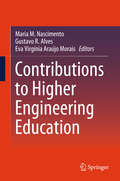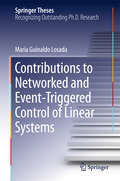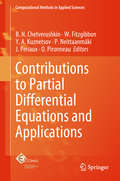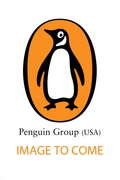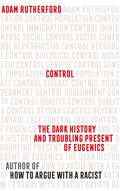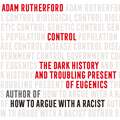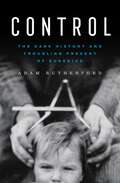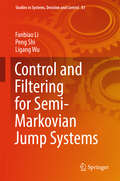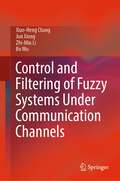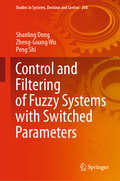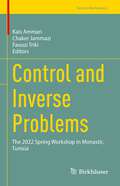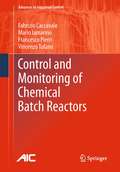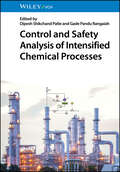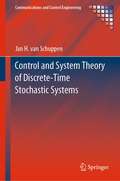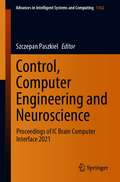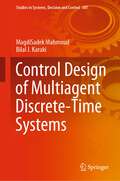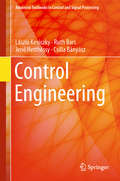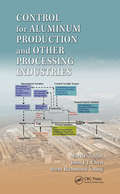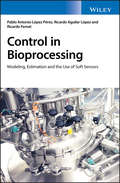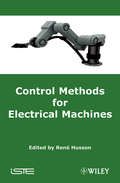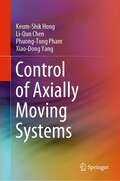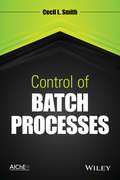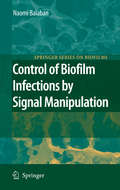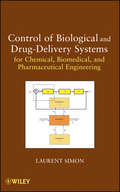- Table View
- List View
Contributions to Higher Engineering Education
by Eva Virgínia Araújo Morais Gustavo R. Alves Maria M. NascimentoThe book focuses on teaching knowledge and principles (Higher Education) regarding professional practice of engineering (life and lifelong learning). It covers recent developments in engineering education. This book comprises the select proceedings of the conference organised by the Portuguese Society for Engineering Education. This book goes beyond the examination of the economic, culture, and social factors, which influence the education of engineers in different higher education institutions, and encompasses critical thinking and problem solving, communication, collaboration and creativity and innovation. These are essential components of engineering education. The contents of this book are useful to researchers and professionals engaged in the re-engineering of engineering education.
Contributions to Networked and Event-Triggered Control of Linear Systems (Springer Theses)
by María Guinaldo LosadaThis book reports on a set of new techniques for resolving current issues in networked control systems. The main focus is on strategies for event-based control, for both centralized and decentralized architectures. The first part of the book addresses the problem of single-loop networked control systems and proposes an anticipative remote controller for dealing with delays and packet losses. The second part of the book proposes a distributed event-based control strategy for networked dynamical systems, which has been implemented in a test-bed of mobile robots, and provides readers with a thorough description of an interactive simulator used to validate the results. This thesis, examined at the Universidad Nacional de Educación a Distancia in 2013, received the award for best thesis in control engineering from the Control Engineering group of the Spanish Committee of Automatic Control in 2015.
Contributions to Partial Differential Equations and Applications (Computational Methods in Applied Sciences #47)
by O. Pironneau J. Periaux P. Neittaanmäki Y. A. Kuznetsov W. Fitzgibbon B. N. ChetverushkinThis book treats Modelling of CFD problems, Numerical tools for PDE, and Scientific Computing and Systems of ODE for Epidemiology, topics that are closely related to the scientific activities and interests of Prof. William Fitzgibbon, Prof. Yuri Kuznetsov, and Prof. O. Pironneau, whose outstanding achievements are recognised in this volume. It contains 20 contributions from leading scientists in applied mathematics dealing with partial differential equations and their applications to engineering, ab-initio chemistry and life sciences. It includes the mathematical and numerical contributions to PDE for applications presented at the ECCOMAS thematic conference "Contributions to PDE for Applications" held at Laboratoire Jacques Louis Lions in Paris, France, August 31- September 1, 2015, and at the Department of Mathematics, University of Houston, Texas, USA, February 26-27, 2016. This event brought together specialists from universities and research institutions who are developing or applying numerical PDE or ODE methods with an emphasis on industrial and societal applications. This volume is of interest to researchers and practitioners as well as advanced students or engineers in applied and computational mathematics. All contributions are written at an advanced scientific level with no effort made by the editors to make this volume self-contained. It is assumed that the reader is a specialist already who knows the basis of this field of research and has the capability of understanding and appreciating the latest developments in this field.
control
by Lydia KangFor fans of Uglies comes a spiraling, intense sci fi thriller."Control blew me away. The twists and turns and suspense made for a thrilling ride. Zel is as authentic a character as I've read in a very long time. Highly recommended" - James Dashner, New York Times bestselling author of The Maze RunnerSet in 2150 -- in a world of automatic cars, nightclubs with auditory ecstasy drugs, and guys with four arms -- this is about the human genetic "mistakes" that society wants to forget, and the way that outcasts can turn out to be heroes.When their overprotective father is killed in a terrible accident, Zel and her younger sister, Dylia, are lost in grief. But it's not until strangers appear, using bizarre sensory weapons, that the life they had is truly eviscerated. Zel ends up in a safe house for teens that aren't like any she's ever seen -- teens who, by law, shouldn't even exist. One of them -- an angry tattooed boy haunted by tragedy -- can help Zel reunite with her sister.But only if she is willing to lose him.
control
by Lydia KangFor fans of Uglies comes a spiraling, intense sci fi thriller. "Control blew me away. The twists and turns and suspense made for a thrilling ride. Zel is as authentic a character as I've read in a very long time. Highly recommended" - James Dashner, New York Times bestselling author of The Maze Runner Set in 2150 -- in a world of automatic cars, nightclubs with auditory ecstasy drugs, and guys with four arms -- this is about the human genetic "mistakes" that society wants to forget, and the way that outcasts can turn out to be heroes. When their overprotective father is killed in a terrible accident, Zel and her younger sister, Dylia, are lost in grief. But it's not until strangers appear, using bizarre sensory weapons, that the life they had is truly eviscerated. Zel ends up in a safe house for teens that aren't like any she's ever seen -- teens who, by law, shouldn't even exist. One of them -- an angry tattooed boy haunted by tragedy -- can help Zel reunite with her sister. But only if she is willing to lose him.
Control: The Dark History and Troubling Present of Eugenics
by Adam Rutherford* FROM THE SUNDAY TIMES BESTSELLING AUTHOR OF HOW TO ARGUE WITH A RACIST *Throughout history, people have sought to improve society by reducing suffering, eliminating disease or enhancing desirable qualities in their children. But this wish goes hand in hand with the desire to impose control over who can marry, who can procreate and who is permitted to live. In the Victorian era, in the shadow of Darwin's ideas about evolution, a new full-blooded attempt to impose control over our unruly biology began to grow in the clubs, salons and offices of the powerful. It was enshrined in a political movement that bastardised science, and for sixty years enjoyed bipartisan and huge popular support. Eugenics was vigorously embraced in dozens of countries. It was also a cornerstone of Nazi ideology, and forged a path that led directly to the gates of Auschwitz. But the underlying ideas are not merely historical. The legacy of eugenics persists in our language and literature, from the words 'moron' and 'imbecile' to the themes of some of our greatest works of culture. Today, with new gene editing techniques, very real conversations are happening - including in the heart of British government - about tinkering with the DNA of our unborn children, to make them smarter, fitter, stronger. CONTROL tells the story of attempts by the powerful throughout history to dictate reproduction and regulate the interface of breeding and society. It is an urgently needed examination that unpicks one of the defining and most destructive ideas of the twentieth century. To know this history is to inoculate ourselves against its being repeated.
Control: The Dark History and Troubling Present of Eugenics
by Adam RutherfordThroughout history, people have sought to improve society by reducing suffering, eliminating disease or enhancing desirable qualities in their children. But this wish goes hand in hand with the desire to impose control over who can marry, who can procreate and who is permitted to live. In the Victorian era, in the shadow of Darwin's ideas about evolution, a new full-blooded attempt to impose control over our unruly biology began to grow in the clubs, salons and offices of the powerful. It was enshrined in a political movement that bastardised science, and for sixty years enjoyed bipartisan and huge popular support. Eugenics was vigorously embraced in dozens of countries. It was also a cornerstone of Nazi ideology, and forged a path that led directly to the gates of Auschwitz. But the underlying ideas are not merely historical. The legacy of eugenics persists in our language and literature, from the words 'moron' and 'imbecile' to the themes of some of our greatest works of culture. Today, with new gene editing techniques, very real conversations are happening - including in the heart of British government - about tinkering with the DNA of our unborn children, to make them smarter, fitter, stronger. CONTROL tells the story of attempts by the powerful throughout history to dictate reproduction and regulate the interface of breeding and society. It is an urgently needed examination that unpicks one of the defining and most destructive ideas of the twentieth century. To know this history is to inoculate ourselves against its being repeated.
Control: The Dark History And Troubling Present Of Eugenics
by Adam RutherfordHow did an obscure academic idea pave the way to the Holocaust within just fifty years? Control is a book about eugenics, what geneticist Adam Rutherford calls “a defining idea of the twentieth century.” Inspired by Darwin’s ideas about evolution, eugenics arose in Victorian England as a theory for improving the British population, and quickly spread to America, where it was embraced by presidents, funded by Gilded Age monopolists, and enshrined into racist American laws that became the ideological cornerstone of the Third Reich. Despite this horrific legacy, eugenics looms large today as the advances in genetics in the last thirty years—from the sequencing of the human genome to modern gene editing techniques—have brought the idea of population purification back into the mainstream. Eugenics has “a short history, but a long past,” Rutherford writes. The first half of Control is the history of an idea, from its roots in key philosophical texts of the classical world all the way into their genocidal enactment in the twentieth century. The second part of the book explores how eugenics operates today, as part of our language and culture, as part of current political and racial discussions, and as an eternal temptation to powerful people who wish to improve society through reproductive control. With disarming wit and scientific precision, Rutherford explains why eugenics still figures prominently in the twenty-first century, despite its genocidal past. And he confronts insidious recurring questions—did eugenics work in Nazi Germany? And could it work today?—revealing the intellectual bankruptcy of the idea, and the scientific impossibility of its realization.
Control and Filtering for Semi-Markovian Jump Systems (Studies in Systems, Decision and Control #81)
by Peng Shi Ligang Wu Fanbiao LiThis book presents up-to-date research developments and novel methodologies on semi-Markovian jump systems (S-MJS). It presents solutions to a series of problems with new approaches for the control and filtering of S-MJS, including stability analysis, sliding mode control, dynamic output feedback control, robust filter design, and fault detection. A set of newly developed techniques such as piecewise analysis method, positively invariant set approach, event-triggered method, and cone complementary linearization approaches are presented. Control and Filtering for Semi-Markovian Jump Systems is a comprehensive reference for researcher and practitioners working in control engineering, system sciences and applied mathematics, and is also a useful source of information for senior undergraduates and graduates in these areas. The readers will benefit from some new concepts, new models and new methodologies with practical significance in control engineering and signal processing.
Control and Filtering of Fuzzy Systems Under Communication Channels
by Xiao-Heng Chang Jun Xiong Zhi-Min Li Bo WuThis book systematically studies the feedback control and filtering problems for nonlinear plants with limited communication channels based on T-S fuzzy models. By fully considering different network-induced phenomena, such as signal quantizations, time-delays, data packet dropouts, communication protocols, cyber attacks, and so on, some significant strategies are provided for various performance analysis and different controller/filter synthesis of fuzzy systems. The event-triggered mechanism is also mentioned to save the communication resource. Moreover, some results are extended to the fault detection and fault-tolerant control. The book provides some new methodologies in analysis and synthesis of fuzzy systems under communication channels, and can serve as a valuable reference material for researchers wishing to explore the area of control and filtering of fuzzy systems and networked systems.
Control and Filtering of Fuzzy Systems with Switched Parameters (Studies in Systems, Decision and Control #268)
by Shanling Dong Zheng-Guang Wu Peng ShiThis book presents recent advances in control and filter design for Takagi-Sugeno (T-S) fuzzy systems with switched parameters. Thanks to its powerful ability in transforming complicated nonlinear systems into a set of linear subsystems, the T-S fuzzy model has received considerable attention from those the field of control science and engineering. Typical applications of T-S fuzzy systems include communication networks, and mechanical and power electronics systems. Practical systems often experience abrupt variations in their parameters or structures due to outside disturbances or component failures, and random switching mechanisms have been used to model these stochastic changes, such as the Markov jump principle. There are three general types of controller/filter for fuzzy Markov jump systems: mode-independent, mode-dependent and asynchronous. Mode-independence does not focus on whether modes are accessible and ignores partially useful mode information, which results in some conservatism. The mode-dependent design approach relies on timely, complete and correct information regarding the mode of the studied plant. Factors like component failures and data dropouts often make it difficult to obtain exact mode messages, which further make the mode-dependent controllers/filters less useful. Recently, to overcome these issues, researchers have focused on asynchronous techniques. Asynchronous modes are accessed by observing the original systems based on certain probabilities. The book investigates the problems associated with controller/filter design for all three types. It also considers various networked constraints, such as data dropouts and time delays, and analyzes the performances of the systems based on Lyapunov function and matrix inequality techniques, including the stochastic stability, dissipativity, and $H_\infty$. The book not only shows how these approaches solve the control and filtering problems effectively, but also offers potential meaningful research directions and ideas. Covering a variety of fields, including continuous-time and discrete-time Markov processes, fuzzy systems, robust control, and filter design problems, the book is primarily intended for researchers in system and control theory, and is also a valuable reference resource for graduate and undergraduate students. Further, it provides cases of fuzzy control problems that are of interest to scientists, engineers and researchers in the field of intelligent control. Lastly it is useful for advanced courses focusing on fuzzy modeling, analysis, and control.
Control and Inverse Problems: The 2022 Spring Workshop in Monastir, Tunisia (Trends in Mathematics)
by Kaïs Ammari Chaker Jammazi Faouzi TrikiThis volume presents a timely overview of control theory and inverse problems, and highlights recent advances in these active research areas. The chapters are based on talks given at the spring school "Control & Inverse Problems” held in Monastir, Tunisia in May 2022. In addition to providing a snapshot of these two areas, chapters also highlight breakthroughs on more specific topics, such as: Controllability of dynamical systems Information transfer in multiplier equations Nonparametric instrumental regression Control of chained systems The damped wave equation Control and Inverse Problems will be a valuable resource for both established researchers as well as more junior members of the community.
Control and Monitoring of Chemical Batch Reactors (Advances in Industrial Control)
by Vincenzo Tufano Francesco Pierri Fabrizio Caccavale Mario IamarinoThe Chemical Batch Reactor is aimed at tackling the above problems from a blending of academic and industrial perspectives. Advanced solutions (i.e., those based on recent research results) to the four fundamental problems of modeling, identification, control and fault diagnosis for batch processes are developed in detail in four distinct chapters. In each chapter, a general overview of foundational concepts is also given, together with a review of recent and classical literature on the various subjects. To provide a unitary treatment of the different topics and give a firm link to the underlying practical applications, a single case study is developed as the book progresses; a batch process of industrial interest, i.e., the phenol-formaldehyde reaction for the production of phenolic resins, is adopted to test the various techniques developed. In this way, a roadmap of the solutions to fundamental problems, ranging from the early stages of the production process to the complete design of control and diagnosis systems, is provided for both industrial practitioners and academic researchers.
Control and Safety Analysis of Intensified Chemical Processes
by Gade Pandu Rangaiah Dipesh Shikchand PatleControl and Safety Analysis of Intensified Chemical Processes Resource on the control and safety analysis of intensified chemical processes, ranging from general methods to specific applications Control and Safety Analysis of Intensified Chemical Processes covers the basic principles of and recent developments in control and safety analysis of intensified chemical processes, ranging from dynamic simulations and safety analysis to the design and control of important processes. The text discusses general methods and tools such as dynamic simulation, control and safety analysis as well as design aspects and analysis of important applications in order to provide scientists and engineers with an understanding of the design, control and safety considerations involved in intensified chemical processes. Sample topics covered in Control and Safety Analysis of Intensified Chemical Processes include: Simulation and optimization methods, common programs and simulators for simulation and optimization, and interfacing of simulators and optimizers Programs/simulators for dynamic simulation and control, tuning of controllers, and popular criteria for control assessment Control of a hybrid reactive-extractive distillation systems for ternary azeotropic mixtures, reactive distillation in recycle systems, and middle vessel batch distillation with vapor recompression Safety analysis of intensified processes (e.g. extractive distillation, dividing wall column, dividing wall column with mechanical vapor recompression, and algal biodiesel process) A comprehensive resource on the subject, Control and Safety Analysis of Intensified Chemical Processes is a highly valuable reference for researchers, students and practitioners interested in process intensification and their applications. The text can be adopted by instructors for use in advanced courses on process control and safety.
Control and System Theory of Discrete-Time Stochastic Systems (Communications and Control Engineering)
by Jan H. van SchuppenThis book helps students, researchers, and practicing engineers to understand the theoretical framework of control and system theory for discrete-time stochastic systems so that they can then apply its principles to their own stochastic control systems and to the solution of control, filtering, and realization problems for such systems. Applications of the theory in the book include the control of ships, shock absorbers, traffic and communications networks, and power systems with fluctuating power flows.The focus of the book is a stochastic control system defined for a spectrum of probability distributions including Bernoulli, finite, Poisson, beta, gamma, and Gaussian distributions. The concepts of observability and controllability of a stochastic control system are defined and characterized. Each output process considered is, with respect to conditions, represented by a stochastic system called a stochastic realization. The existence of a control law is related to stochastic controllability while the existence of a filter system is related to stochastic observability. Stochastic control with partial observations is based on the existence of a stochastic realization of the filtration of the observed process.
Control, Computer Engineering and Neuroscience: Proceedings of IC Brain Computer Interface 2021 (Advances in Intelligent Systems and Computing #1362)
by Szczepan PaszkielThis book presents the proceedings of the 4th International Scientific Conference IC BCI 2021 Opole, Poland. The event was held at Opole University of Technology in Poland on 21 September 2021. Since 2014, the conference has taken place every two years at the University’s Faculty of Electrical Engineering, Automatic Control and Informatics. The conference focused on the issues relating to new trends in modern brain–computer interfaces (BCI) and control engineering, including neurobiology–neurosurgery, cognitive science–bioethics, biophysics–biochemistry, modeling–neuroinformatics, BCI technology, biomedical engineering, control and robotics, computer engineering and neurorehabilitation–biofeedback.
Control Design of Multiagent Discrete-Time Systems (Studies in Systems, Decision and Control #387)
by MagdiSadek Mahmoud Bilal J. KarakiThis book describes an effective approach to the cooperative and coordinated control of multivehicle systems. This rigorous analytic approach guarantees the stability of coordinated and cooperating vehicles using distributed protocols and uses low-energy, event-triggered mechanisms for networked vehicle control. The text covers: design of a cooperative protocol to achieve consensus for multivehicle systems, allowing cooperation that is resistant to the effects of packet loss and/or adversarial attack; analysis and synthesis of an event-triggering mechanism for cooperative multivehicle systems over uncertain networks; and the problem of distributed leader-following consensus and methods for compelling multivehicle systems to reach consensus. Throughout the book, cooperation problems are transformed into stability problems. Lyapunov theory is used to guarantee cooperation among agents. The distributed approach is applied to triggering mechanisms, the cooperation process, and the impact of cyber-attacks. Discrete-time analysis shows how the event-based structure can be designed to match the performance of continuous-time counterparts. The book details applications and computer simulation with several practical examples. This book is of interest to a wide audience from the graduate student, through the academic researcher to the industrial practitioner, all of them sharing a common interest in the stability and security of multiagent systems.
Control Engineering: From The Basics To The Applications (Advanced Textbooks in Control and Signal Processing)
by László Keviczky Ruth Bars Jenő Hetthéssy Csilla BányászThis book offers fundamental information on the analysis and synthesis of continuous and sampled data control systems. It includes all the required preliminary materials (from mathematics, signals and systems) that are needed in order to understand control theory, so readers do not have to turn to other textbooks. Sampled data systems have recently gained increasing importance, as they provide the basis for the analysis and design of computer-controlled systems. Though the book mainly focuses on linear systems, input/output approaches and state space descriptions are also provided. Control structures such as feedback, feed forward, internal model control, state feedback control, and the Youla parameterization approach are discussed, while a closing section outlines advanced areas of control theory. Though the book also contains selected examples, a related exercise book provides Matlab/Simulink exercises for all topics discussed in the textbook, helping readers to understand the theory and apply it in order to solve control problems. Thanks to this combination, readers will gain a basic grasp of systems and control, and be able to analyze and design continuous and discrete control systems.
Control for Aluminum Production and Other Processing Industries
by Mark P. Taylor John J. Chen Brent Richmond YoungAn uncomfortable observation in the Shift Logs and Process Control records of most aluminum smelting plants is that process control failures, large and small, happen every day. Although only a small fraction of these failures give rise to catastrophic events, the difference between a disaster we read about and a failure which, although expensive, h
Control in Bioprocessing: Modeling, Estimation and the Use of Soft Sensors
by Pablo A. López Pérez Ricardo Aguilar López Ricardo FematCloses the gap between bioscience and mathematics-based process engineering This book presents the most commonly employed approaches in the control of bioprocesses. It discusses the role that control theory plays in understanding the mechanisms of cellular and metabolic processes, and presents key results in various fields such as dynamic modeling, dynamic properties of bioprocess models, software sensors designed for the online estimation of parameters and state variables, and control and supervision of bioprocesses Control in Bioengineering and Bioprocessing: Modeling, Estimation and the Use of Sensors is divided into three sections. Part I, Mathematical preliminaries and overview of the control and monitoring of bioprocess, provides a general overview of the control and monitoring of bioprocesses, and introduces the mathematical framework necessary for the analysis and characterization of bioprocess dynamics. Part II, Observability and control concepts, presents the observability concepts which form the basis of design online estimation algorithms (software sensor) for bioprocesses, and reviews controllability of these concepts, including automatic feedback control systems. Part III, Software sensors and observer-based control schemes for bioprocesses, features six application cases including dynamic behavior of 3-dimensional continuous bioreactors; observability analysis applied to 2D and 3D bioreactors with inhibitory and non-inhibitory models; and regulation of a continuously stirred bioreactor via modeling error compensation. Applicable across all areas of bioprocess engineering, including food and beverages, biofuels and renewable energy, pharmaceuticals and nutraceuticals, fermentation systems, product separation technologies, wastewater and solid-waste treatment technology, and bioremediation Provides a clear explanation of the mass-balance–based mathematical modelling of bioprocesses and the main tools for its dynamic analysis Offers industry-based applications on: myco-diesel for implementing "quality" of observability; developing a virtual sensor based on the Just-In-Time Model to monitor biological control systems; and virtual sensor design for state estimation in a photocatalytic bioreactor for hydrogen production Control in Bioengineering and Bioprocessing is intended as a foundational text for graduate level students in bioengineering, as well as a reference text for researchers, engineers, and other practitioners interested in the field of estimation and control of bioprocesses.
Control Methods for Electrical Machines
by René HussonThe type of control system used for electrical machines depends on the use (nature of the load, operating states, etc.) to which the machine will be put. The precise type of use determines the control laws which apply. Mechanics are also very important because they affect performance. Another factor of essential importance in industrial applications is operating safety. Finally, the problem of how to control a number of different machines, whose interactions and outputs must be coordinated, is addressed and solutions are presented. These and other issues are addressed here by a range of expert contributors, each of whom are specialists in their particular field. This book is primarily aimed at those involved in complex systems design, but engineers in a range of related fields such as electrical engineering, instrumentation and control, and industrial engineering, will also find this a useful source of information.
Control of Axially Moving Systems
by Keum-Shik Hong Li-Qun Chen Phuong-Tung Pham Xiao-Dong YangThis book provides a comprehensive guideline on dynamic analysis and vibration control of axially moving systems. First, the mathematical models of various axially moving systems describing the string, beam, belt, and plate models are developed. Accordingly, dynamical issues such as the equilibrium configuration, critical velocity, stability, bifurcation, and further chaotic dynamics are analyzed. Second, this book covers the design of the control schemes based on the hitherto control strategies for axially moving systems: feedback control using the transfer function, variable structure control, control by regulating the axial velocity, wave cancellation approach, boundary control using the Lyapunov method, adaptive control, and hybrid control methods. Finally, according to the contents discussed in the book, specific aspects are outlined for initiating future research endeavors to be undertaken concerning axially moving systems. This book is useful to graduate students and researchers in industrial sectors such as continuous manufacturing systems, transport systems, power transmission systems, and lifting systems not to mention in academia.
Control of Batch Processes
by Cecil L. SmithGives a real world explanation of how to analyze and troubleshoot a process control system in a batch process plant* Explains how to analyze the requirements for controlling a batch process, develop the control logic to meet these requirements, and troubleshoot the process controls in batch processes* Presents three categories of batch processes (cyclical batch, multigrade facilities, and flexible batch) and examines the differences in the control requirements in each* Examines various concepts of a product recipe and what its nature must be in a flexible batch facility* Approaches the subject from the process perspective, with emphasis on the advantages of using structured logic in the automation of all but the simplest batch processes.* Discusses the flow of information starting at the plant floor and continuing through various levels of the control logic up to the corporate IT level
Control of Biofilm Infections by Signal Manipulation (Springer Series on Biofilms #2)
by Naomi Balaban J. W. CostertonThe number of patients affected by and dying from what can be considered as a "biofilm disease" is higher than heart disease and cancer combined. Thus, this is a hugely important work that describes the molecular mechanisms of cell-to-cell communication among bacterial cells in a biofilm, the development of antibiofilm inhibitors such as quorum-sensing inhibitors, and the use of biofilm inhibitors to prevent and treat bacterial infections in humans and other animals.
Control of Biological and Drug-Delivery Systems for Chemical, Biomedical, and Pharmaceutical Engineering
by Laurent SimonEnables readers to apply process dynamics and control theory to solve bioprocess and drug delivery problemsThe control of biological and drug delivery systems is critical to the health of millions of people worldwide. As a result, researchers in systems biology and drug delivery rely on process dynamics and control theory to build our knowledge of cell behavior and to develop more effective therapeutics, controlled release devices, and drug administration protocols to manage disease.Written by a leading expert and educator in the field, this text helps readers develop a deep understanding of process dynamics and control theory in order to analyze and solve a broad range of problems in bioprocess and drug delivery systems. For example, readers will learn how stability criteria can be used to gain new insights into the regulation of biological pathways and lung mechanics. They'll also learn how the concept of a time constant is used to capture the dynamics of diffusive processes. Readers will also master such topics as external disturbances, transfer functions, and input/output models with the support of the author's clear explanations, as well as:Detailed examples from the biological sciences and novel drug delivery technologies160 end-of-chapter problems with step-by-step solutionsDemonstrations of how computational software such as MATLAB and Mathematica solve complex drug delivery problemsControl of Biological and Drug-Delivery Systems for Chemical, Biomedical, and Pharmaceutical Engineering is written primarily for undergraduate chemical and biomedical engineering students; however, it is also recommended for students and researchers in pharmaceutical engineering, process control, and systems biology. All readers will gain a new perspective on process dynamics and control theory that will enable them to develop new and better technologies and therapeutics to treat human disease.
